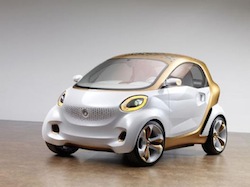Daimler, in conjunction with BASF and the American Chemistry Council (ACC), have unveiled a new smart forvision concept vehicle that was designed to save energy and enhance sustainability through vehicle efficiency. One of the energy-efficiency features is a light-transmitting roof with solar cells designed to generate energy and power the vehicle’s climate control system. In addition, the car features an infrared-reflective film developed by BASF, affixed in the windscreen and side windows. The technology protects the car interior from heating up in the summer.
 “We are proud to have developed a holistic concept for sustainable urban mobility in cooperation with Daimler,” said Dr. Martin Jung, BASF’s automotive research spokesperson. “Together we are presenting a pioneering vehicle which is without parallel.”
“We are proud to have developed a holistic concept for sustainable urban mobility in cooperation with Daimler,” said Dr. Martin Jung, BASF’s automotive research spokesperson. “Together we are presenting a pioneering vehicle which is without parallel.”
Part of the goal of the project is to demonstrate “Chemistry to Energy”. Chemistry has the power to increase energy efficiency while also reducing the amount of energy consumed. According to an ACC study, chemistry in energy-saving products and technologies have the capability to save upwards of 10.9 quadrillion Btus of energy each year. This is staggering: this amount of energy can power up to 56 million average sized homes or enough to power 135 million cars each year. This level of energy savings could also save $85 billion in energy costs per year.
During the next several weeks, ACC is featuring a series that spotlights how chemistry is aiding in energy efficiency technologies. You can learn more at the “From Chemistry to Energy” website.

